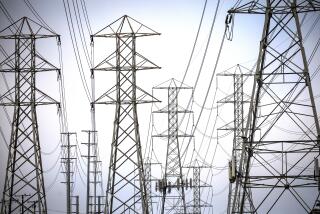The Anatomy of a Phone Bill
- Share via
Back in those innocent days recalled in Pacific Bell’s TV commercials about the two lifelong friends who grew up sweet on Mary Ellen, dealing with the telephone was simple.
There was a rotary dial and a monthly bill and that was about it, unless Grandma’s unexpected death in New Orleans required getting out the egg timer to make sure a scratchy long-distance call didn’t last more than three minutes and cost more than a Sunday at Knott’s Berry Farm.
Today, the twin gods of technology and deregulation have changed some things.
Most phones have buttons and the connections are clear whether a call goes to Disneyland or to Granddad sightseeing in Bali. And long distance is cheap.
But the monthly phone bill is another matter. It’s become a modern Gordian knot.
There are basic charges and universal surcharges, ZUM, tax (local) and tax (federal). There’s a charge for policing the telephone company and another to subsidize telephone service for the deaf and disabled and another to call 911. And there’s also a monthly charge for access to the long-distance companies.
How’s a customer to unravel it all?
Here’s an economic autopsy of the monthly residential telephone bills issued by Pacific Bell--which serves about 80% of the California market--and an explanation of some of the economic and political forces that made it what it is today.
The basic rate for residential service is $8.25 monthly for Pacific Bell. (The monthly basic rate for General Telephone of California, whose scattered service areas include the Westside, is $9.75.)
These basic rates are kept low to allow as many Californians as possible to have telephones. Currently, though, about one in every 15 Californians does not have a residential telephone.
Also to hold down basic rates, said Glenn F. Sullivan, PacBell’s vice president for rate making, customers are charged more than the actual cost of service for most other items on their telephone bill, including PacBell toll charges.
Pacific Bell provides toll service only within 10 Local Access Telephone Areas inside the state. Other long-distance calling--say, the lucrative traffic between Los Angeles and the Bay Area--is handled by long-distance carriers like AT&T;, Sprint and MCI.
Those who buy the unlimited local calling--the $8.25 monthly covers calls within a radius of 8 miles--pay Zone Unit Message charges for calls to ZUM 2 (9-12 miles) and ZUM 3 (13-16 miles) from their local exchange.
ZUM charges are about half of what toll calls would be under the Public Utilities Commission tariff formulas. Pacific Bell says the typical customer’s ZUM calls cost $3.50 per month.
Even so, ZUM charges are much higher than costs. Together ZUM and those toll calls made within PacBell’s system generated an extra $1.1 billion in 1986 that helped hold down the basic rate.
PUC staff documents show growing concern that large telephone users soon may be able to bypass the local exchange companies like Pacific Bell, cutting into the ZUM revenues that help hold down the basic service charge.
In addition to the basic and ZUM rates, customers can buy add-ons or premium services, many of which are money makers that help hold down the cost of basic monthly service.
Customers can buy three Call Bonus plans that give 30% discounts on calls during specific hours (Wide Area Plan), to specific prefixes (Community Plan), or anywhere in the 17-40 mile range (Community Circle).
Whether these plans are worthwhile depends on usage patterns. PacBell service reps will check a customer’s bill for the last three months and advise, over the telephone, whether this or any other option is worth the money for the customer, Sullivan said.
Some Buy Premium Features
One in four customers buys premium features such as call waiting, which allows a call to be placed on hold while a second call is received, call forwarding, which diverts calls to another number, or three-way calling, which allows conference calls.
Customers pay $3.50 per month for call waiting. Sullivan said the actual cost of the service is 78 cents per month, although new figures may soon show it is $1.12.
Overall, Sullivan said, Pacific Bell collects $120 million for premium services and earns $40 million or a 33% margin on sales.
Sylvia Siegel, executive director of Toward Utility Rate Normalization, a consumer advocacy group, has no trouble with Pacific Bell charging premium rates for services such as call waiting because “that’s not plain old telephone service. Anybody who wants anything fancy, they can pay for it.”
The $2.60 monthly charge for access to the long distance carriers--which all customers pay even if they never make or receive long distance calls--is mandated by the Federal Communications Commission.
This fee also helps subsidize local telephone service, which was subsidized by long distance charges before Ma Bell was separated from her baby bells by U.S. District Judge Harold H. Greene. One PUC staff report says this fee accounts for 30% of PacBell’s revenues and two-thirds of its profits.
Charges for directory assistance, 411, began in the 1970s, when Pacific Bell began talking about putting everyone on measured service--a charge for each call--and it wanted to hold down usage because of problems raising capital to expand the telephone network.
“Go measured or go broke” was the idea, Sullivan said.
But now that PacBell has capacity aplenty, the talk has turned to the problem of getting people to use the local telephone system more.
Usage Means Profit
“All profit flows from usage of the system,” Sullivan said. “If we don’t start encouraging use of the network and discouraging barriers to usage we are going to miss the marketing opportunities of the 1990s and beyond.”
So the price of calling 411 may go down, the number of free calls (currently five) may go up or the phone company may add more directory assistance services.
Siegel believes, however, that PacBell wants to move customers toward more measured service because then “all they have to do is raise one unit of time by one penny and they take in $100 million a year. And who’s going to get upset over something that’s described as a one-penny hike?”
The universal service surcharge--4% of those toll charges billed by Pacific Bell and other local telephone exchange companies for toll calls within their systems--subsidizes Lifeline, a ‘70s idea that even Pacific Bell endorses, to give the poor a price break on basic service.
Lifeline used to cost $1.48 per month for up to 60 calls, plus a fee for each additional call.
But 14 months ago the state Legislature adopted a bill by Assemblywoman Gwen Moore (D-Los Angeles) expanding Lifeline to unlimited local calling for $3 to anyone who signs a form declaring their gross income as of Tuesday, is less than $12,500 annually for one or two people, or more for larger families.
Many Lifeline Customers
“We’ve gone from less than half a million Lifeline customers to more than 1 million,” Sullivan said.
Sullivan said there is no effective way for Pacific Bell to check customers’ claims of low income. He said physicians and others whose incomes surely exceed the poverty line have ordered Lifeline. That claim is undoubtedly true, say Siegel and David M. Shantz, chief of the telecommunications rate design branch of the PUC’s division of rate payer advocates.
The rate surcharge on the monthly phone bill is a bookkeeping device to handle changes in how much money the telephone company needs between major rate cases. Currently it is a credit of 0.193% on most user charges.
The state regulatory fee is a 0.1% charge on other charges that funds the PUC. Similar fees are added to bills from electric, gas, water and other investor-owned utilities regulated by the state.
Communication Devices Funds for Deaf and Disabled is a dime-a-line charge to provide the deaf with typewriter-like devices to send written messages over the telephone lines and specialized equipment for other disabled individuals.
The charge raises $20 million annually, but costs are running $32 million per year and the fund is expected to go broke this month, Shantz said.
New Service Taking Over
The reason is a new service that has proved enormously popular.
Deaf and disabled people can now send teletyped messages to an operator who, in turn, will verbally pass the information on to a hearing person, get a response and pass it back. The 24-hour service makes it possible for deaf people to effectively “speak” with the hearing world whether they want to order a pizza or summon a doctor.
Legislation pending in Sacramento would authorize the PUC to raise this charge to cover actual costs.
Many local governments also impose a utility users tax to raise revenue.
The city of Los Angeles imposes a 10% tax and last October it expanded the rate base to include long-distance calls outside of California, which the city clerk’s office said is expected to increase revenue from $99 million to more than $131 million.
The federal telephone tax, now 3%, dates to World War II, when it was adopted as a temporary measure.
The 911 tax funds the universal emergency call network for police, firefighters or paramedics. Now that metropolitan areas have enhanced 911--which gives authorities the telephone number and location from which a call is placed--the fund surplus may be used to provide this service in rural areas.
Late charges began in August, 1984, after Pacific Bell identified this as a way to generate more money that did not add to the basic rate. These charges bring PacBell $600,000 monthly, testimony before the PUC shows.
There’s a hint of a little good news for future phone bills.
For years PacBell has been pouring billions of dollars into new technology, for fiber optic lines with virtually limitless capacity and digital switches so business customers with computers can cheaply shoot billions of bytes down the line.
Investments Mostly Complete
These multibillion-dollar investments are pretty much completed. In addition, new technology has helped the company shed nearly half its work force. And the 1986 federal income tax overhaul will cut Pacific Bell’s obligation to Uncle Sam by an estimated $270 million this year.
As a result, Pacific Bell collects about $500 million extra each year.
Shantz said that means somewhere down the road PacBell’s customers can expect a monthly credit of about $3.50 for every month Pacific Bell collects the surplus.
Or, he said, maybe some charges like the $1.20 per month for Touchtone service, which allows push-button phones to use new cost-saving technology, will vanish.
Bigger Breaks Sought
But Siegel thinks residential customers deserve much bigger breaks.
“Universal service” is a utility dogma saluted by everyone formally associated with telephone rate cases.
While Pacific Bell’s basic rate for unlimited local calling is $8.25, Sullivan says it costs $24.71 to provide that basic service.
Siegel called the figure “an outrageous lie.” If basic residential service was treated as a “stand-alone,” she said, the costs would be so low that basic service could drop to $6. PacBell wants to raise the rate to $10.
The PUC’s Shantz declined to comment on Siegel’s remark but said that “we think $24.71 is too high.”
Overinvestment Charged
Siegel, who has been fighting Pacific Bell in rate cases for two decades, said Pacific Bell has vastly overinvested in equipment useful only to big business and unfairly allocates these costs to residential customers.
Sullivan said the cost allocation methods follow accepted accounting practices, have been intensely reviewed in PUC hearings and are reasonable.
Sullivan also said PacBell has not invested excessively in plant and equipment. But the PUC is penalizing Pacific Bell with a slight profit penalty for excessive investment in plant and equipment.
More to Read
Sign up for Essential California
The most important California stories and recommendations in your inbox every morning.
You may occasionally receive promotional content from the Los Angeles Times.










